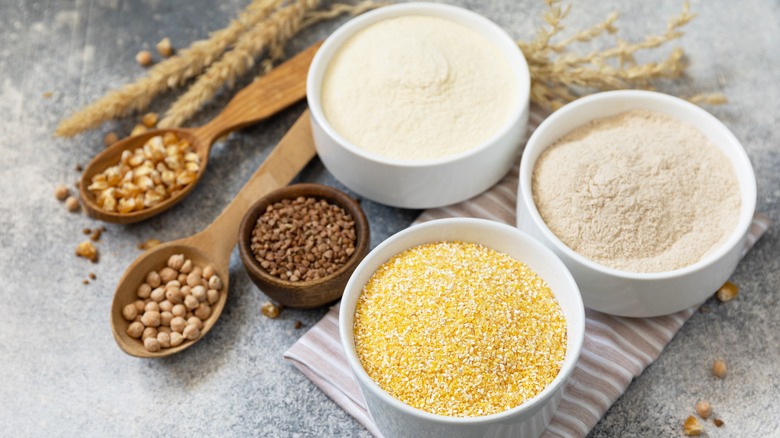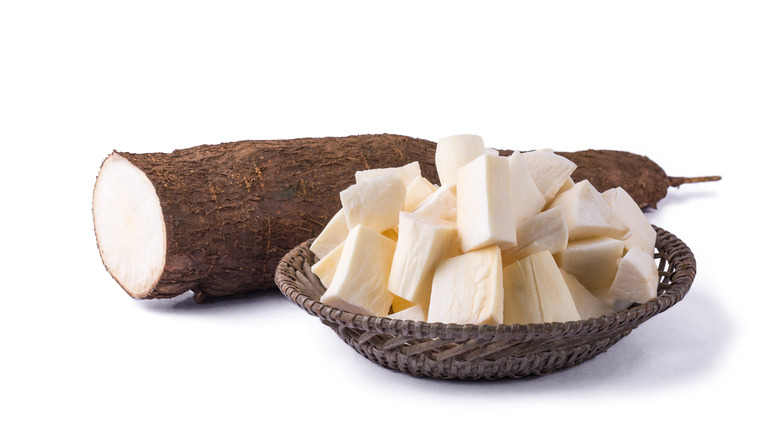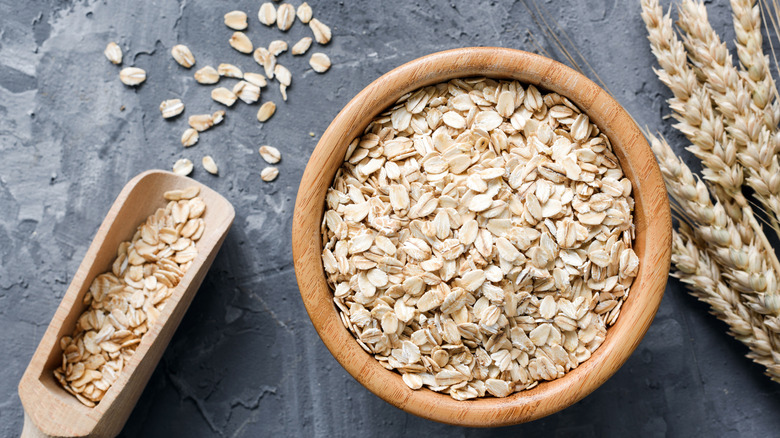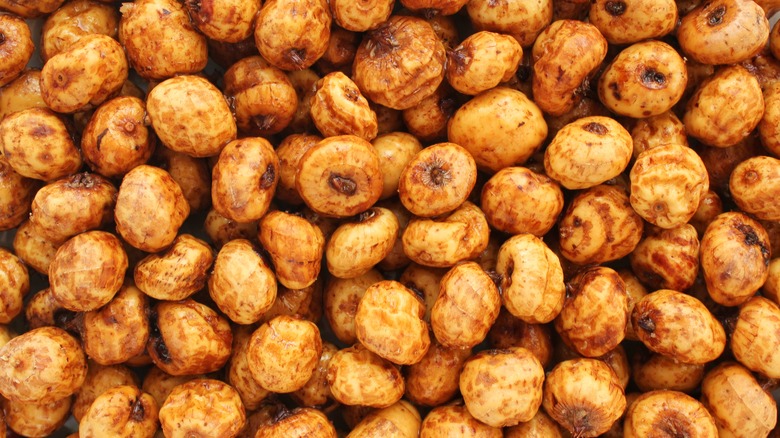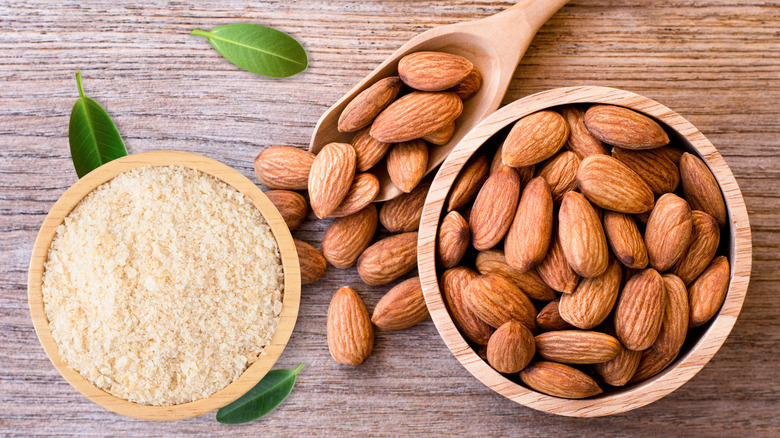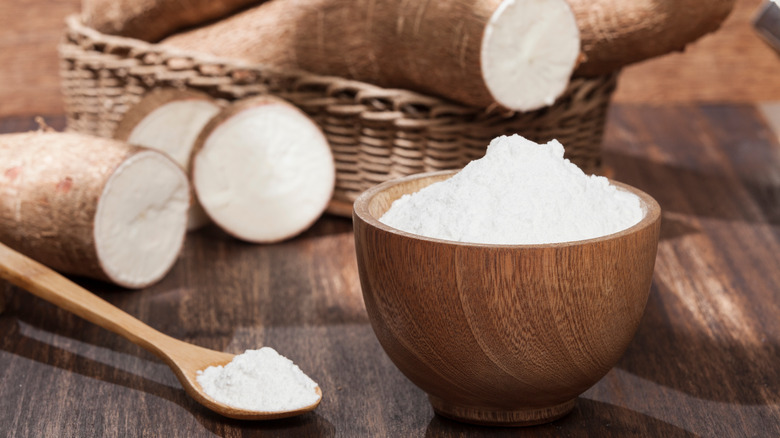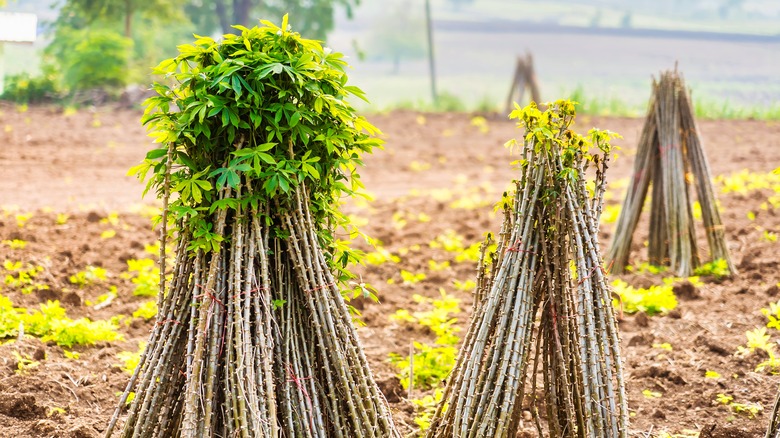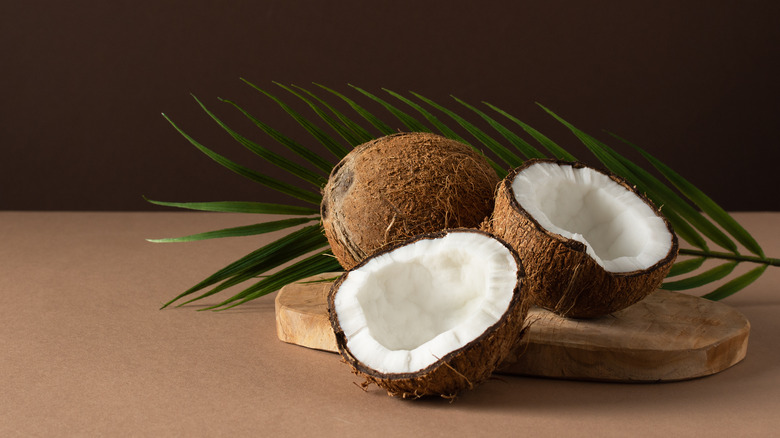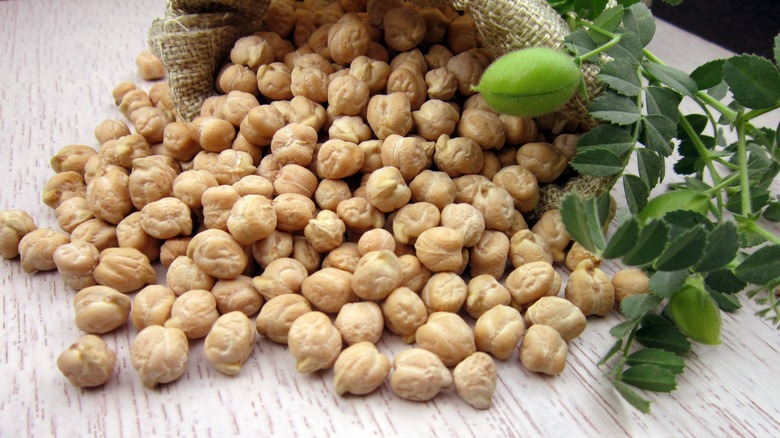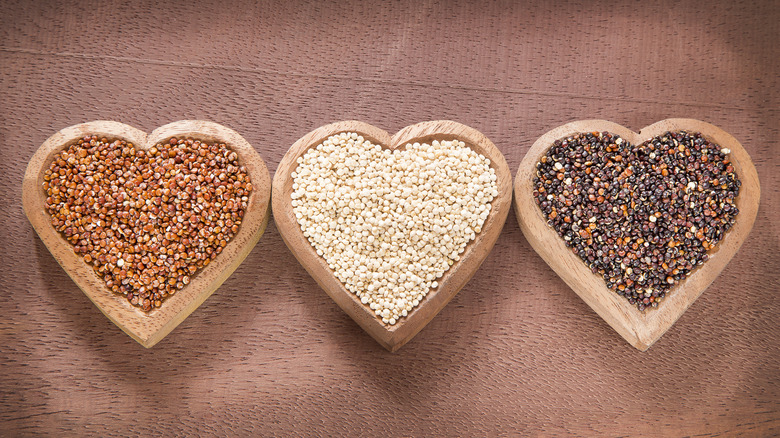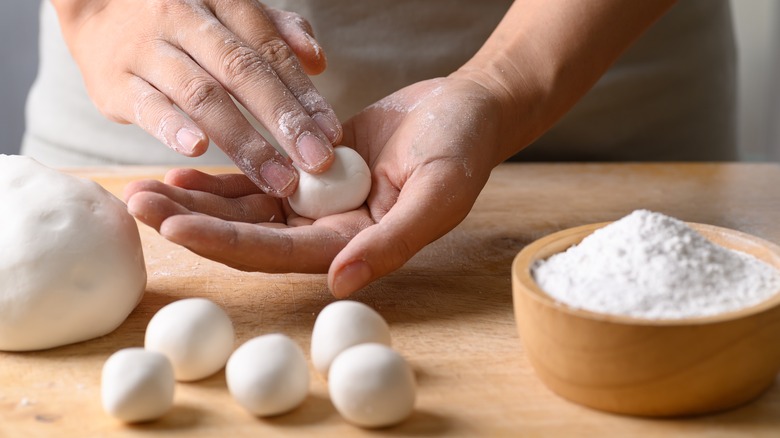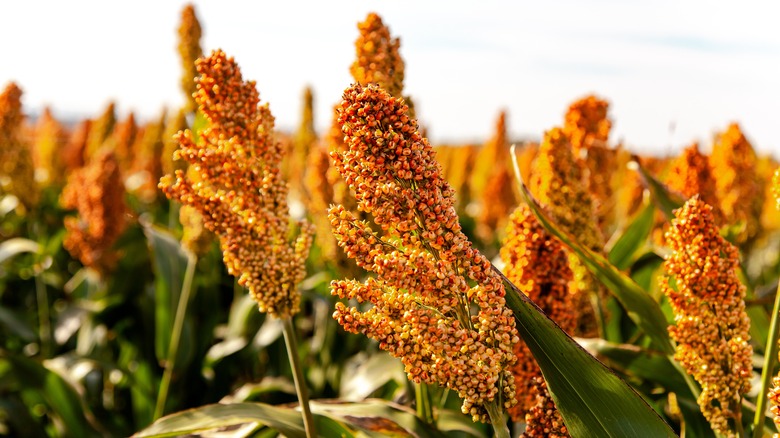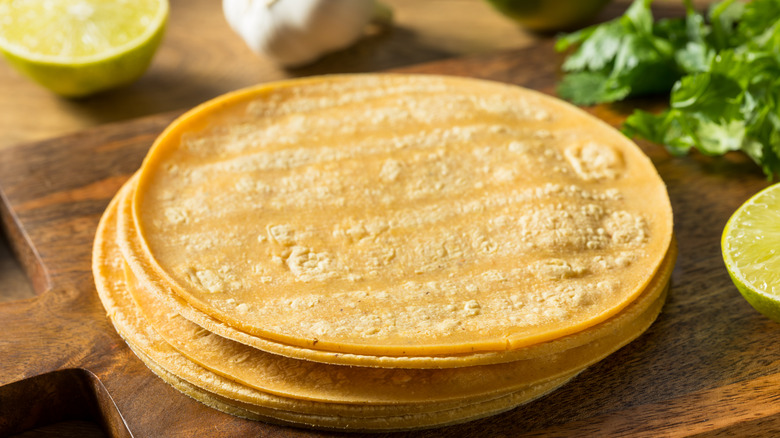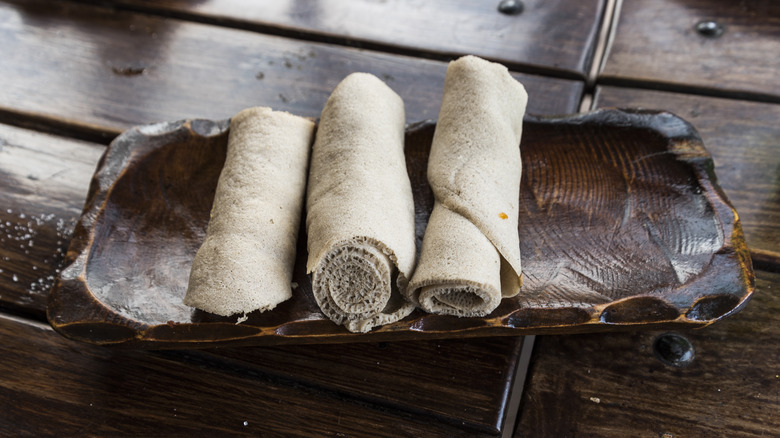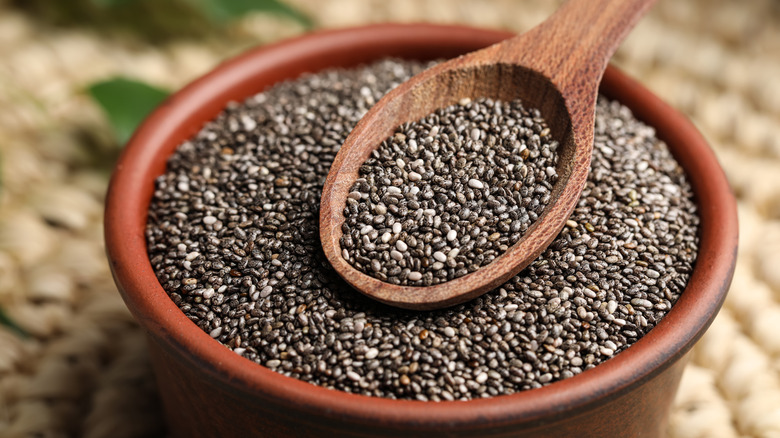15 Types Of Gluten-Free Flours, Explained
As little as a decade ago, grocery store shelves held limited options for people suffering from Celiac disease and other gluten sensitivity-related conditions. However, gluten-free eating is a staple in many of the hottest fad diets that have taken over the wellness landscape over the last few years. Popular diets like the Whole 30, the South Beach diet, and the Master Cleanse emphasize eating foods with no (or very limited) gluten in an effort to reduce the intake of carbohydrates, and the commercial success of such movements led to an explosion of gluten-free products on grocery store shelves, in specialty shops online, and even in fast food restaurants.
Although there is no substantial research that shows that a gluten-free diet will prevent disease or help everyone to lose weight (per Harvard Health Publishing), many people nowadays still choose to limit or eliminate gluten from their diets entirely regardless of whether they struggle with gluten sensitivity — and the market has responded to the demand for such products in a big way. In the past, it was particularly difficult to find baked goods sans gluten, but these days, you'll find a sizable collection of GF bread, pastries, and desserts in most grocery stores along with an entire world of recipes online. Baking typically requires flour of some sort, and thankfully, there's no shortage of exciting gluten-free flour available to amateur bakers and professional pastry chefs alike today. Here are some gluten-free flours derived from grains, nuts, seeds, root vegetables, and more.
Arrowroot flour
Arrowroot flour is derived from the arrowroot plant, which is native to tropical regions like Indonesia, Sri Lanka, and the Caribbean. It's a favorite among those with gluten sensitivity issues because of its nondescript taste as a food product and how easy it is to digest, but it comes with a host of other nutritional benefits. As Medical News Today explains, arrowroot flour is loaded with fiber and actually may contain even more protein than other root vegetables, some of which (like cassava and potato) can also be processed into GF flours. If you're gluten-free and need to increase your protein, try implementing arrowroot powder into your cooking routine.
Arrowroot flour is similar to cornstarch – both are gluten-free and have similar culinary uses. Arrowroot powder and cornstarch are commonly used to increase viscosity for things like soups, jellies, stews, sauces, and even some dressings. Both of these thickening agents have a mild taste and won't affect the flavor of whatever liquid you're thickening with it. In baking, you can use arrowroot powder as a substitute for all-purpose flour by using a ratio of two parts AP flour to one part arrowroot flour. It's a common stand-in for regular flour in bread and cake recipes, so the next time you're asked to prepare dessert for a gluten-free friend or family member, keep arrowroot flour in mind!
Oat flour
Oats have enjoyed a prime spot in the limelight for some time now due to fads like overnight oats, oat milk, and now oat flour. As Verywell Fit explains, oat flour makes for a healthy gluten-free flour substitute as it's low-fat, a great source of complex carbs, and high in protein. It's also easy and cheap to make at home — to make your own oat flour, just blend up whole-grain rolled oats in a high-speed blender until they've been pulverized to the fine consistency of flour. It's important to note that while oats are gluten-free on their own, they're often processed on equipment that is also used to manufacture foods that do contain gluten. Those concerned about cross-contamination should make sure to select oats or oat flour that is clearly labeled "gluten-free."
In cooking and baking, oat flour can be substituted for regular flour in equal parts (if a recipe calls for one cup of AP flour, you can substitute 1 cup of oat flour in its place). If oatmeal conjures up visions of breakfast foods for you, you may enjoy swapping out oat flour for regular flour in pancake, muffin, or banana bread recipes, but it can also be used to make other baked goods like sandwich bread, cakes, and cookies.
Tiger nut flour
Don't let the name fool you: Tiger nuts are not nuts at all, they're actually tubers. An ancient root vegetable native to certain regions of Africa and Spain, (NPR reports that tiger nuts have been discovered in Egyptian tombs thought to have been constructed in the 4th millennium BC), tiger nuts have become a darling among Paleo lifestyle acolytes in recent years due to the fact that they contain no gluten, nuts, or grains. These versatile root veggies can be made into many different products, including tiger nut milk, butter, and, yes, flour. Because they are nut-free, flour made from tiger nuts is a good GF alternative for those with nut allergies.
Tiger nut flour contains a high concentration of fiber (10 grams per ⅓ cup, which is the recommended serving size, according to Nutritionix), so it's easier to digest than some of the other GF flours available, like cassava flour. Unbound Wellness explains that tiger nut flour's taste and texture are similar to almond flour — crumbly in texture, and sweet and nutty in taste. It can be substituted for recipes that call for almond flour or wheat flour in a 1-to-1 ratio. Tiger nut flour can also be combined with another GF flour with a higher starch content (rice flour, potato starch, and tapioca flour are all good starchy options) for more effective binding.
Almond flour
Almond flour is one of the most common and readily available forms of gluten-free flour. Not to be confused with almond meal, which is more dense and coarse, almond flour is made by blanching skinned almonds, drying them out, and then grinding them into fine flour before packaging, per Blue Diamond. If you have de-skinned blanched almonds or almond slivers at home, you can make your own almond flour in much the same way as oat flour. Simply place the almonds in a high-speed blender or food processor and blend until a fine consistency is reached.
Almonds and other nuts are known to be great sources of unsaturated fat, and the same is true for almond flour, according to WebMD. It's also rich in manganese, magnesium, and vitamin E, all of which help improve body and brain function. Almond flour is one of the most popular flours used in gluten-free recipes, but it can also be substituted for regular AP flour in a 1-to-1 ratio in non-GF recipes. Note that you may need to adjust the number of eggs used in baking recipes — recipes utilizing almond flour may require an extra egg in order to bind ingredients effectively. Use almond flour to whip up some delicious gluten-free muffins, tortillas, or this nutty coffee cake.
Tapioca flour
One of the most versatile gluten-free flours is tapioca flour, which is made by extracting the starchy liquid from the roots of the cassava plant (unlike cassava flour, which is made from the plant's entire root). When you hear the word "tapioca," chances are you think of the tapioca pearls that are commonly added to bubble tea, but cassava flour is an entirely different beast — although its high starch content does mean that tapioca flour becomes gummy like the pearls when combined with a liquid. As WebMD explains, tapioca flour has zero fat or cholesterol and is very high in carbs (26 grams per ¼ cup serving), but its other nutritional benefits are negligible — it contains almost no fiber, protein, vitamins, or other minerals.
Still, because of its mild and neutral taste, and the fact that it contains no gluten, tapioca flour is a popular choice of flour for both savory cooking and sweet baking recipes. Dr. Axe recommends substituting it for wheat flour at a 1-to-1 ratio and asserts that if using tapioca flour to thicken liquids like soups or sauces, less is more. In addition to its effectiveness as a thickening agent, tapioca flour is great for creating gluten-free flatbreads, cookies, pizza crusts, sandwich bread, and other baked goods.
Cassava flour
Like tapioca, cassava flour is also derived from the cassava plant — but cassava flour contains the plant's entire root, versus tapioca flour which only includes the starchy part. As Medical News Today explains, cassava flour is made by taking small pieces of grated cassava root, drying the pieces out, and then pulverizing the dried morsels into a superfine powder. Cassava flour is richer in fiber than tapioca flour, so while tapioca is a fine thickener on its own, cassava is even better due to its higher starch content. Cassava flour is thought to aid in digestion and promote gut health and subsequently may help stave off ailments and illnesses such as constipation, Crohn's disease, and even colorectal cancer.
Mikey's describes the taste of cassava flour as nutty and earthy, and it's a little more noticeable in food than flavorless, odorless tapioca flour. Still, it's a popular choice in gluten-free cooking and baking and can be substituted in equal parts for all-purpose flour in most recipes. Recently, it's even been used in quite a few pre-made store products, like Aldi's popular grain-free pretzels. Use it to make pasta dough, brownies, banana bread, and other baked goods. Given that cassava flour is grain, nut, and gluten-free, it's a great choice for those whose food sensitivities and diet limitations extend beyond gluten.
Coconut flour
Made from the dried and ground meat of coconuts, coconut flour is a popular GF substitute and is especially beloved as a substitute for cake flour in the baking world because of its sweet taste. It also comes with quite a few health benefits that make it stand out: As WebMD explains, coconut flour is relatively high in fiber, fats, protein, and iron compared to both all-purpose flour and other gluten-free flour. With iron being its main component, it's especially good for those following vegetarian and vegan diets, which can make it difficult to get enough iron.
Coconut flour is more absorbent than AP flour and absorbs much more liquid. When substituting it for regular flour, Nourished Kitchen recommends using a ratio of 1-to-4 coconut flour to AP flour. If you're substituting coconut flour for AP flour in a recipe that involves eggs, you'll also want to use an additional egg for every ¼ cup of coconut flour — again speaking to coconut flour's high absorption capabilities. Keep in mind that this kind of flour has a powerful taste and will give anything it's added to a hint (or more) of coconut flavor — but even for those who don't enjoy the taste of coconut, it can be a nice addition to crepes, cookies, donuts, and more.
Chickpea flour
Chickpeas (also known as garbanzo beans) are an incredibly nutrient-dense legume, and chickpea flour carries many of the same dietary advantages. Dr. Axe tells us that chickpea flour is high in fiber, contains lots of vitamins and minerals like calcium and magnesium, and packs a high concentration of folate, which is excellent for prenatal development. Chickpea flour is actually still commonly used in parts of the Middle East and Asia as default, as opposed to being a substitute for AP flour, and some researchers believe that consuming garbanzo beans and other legumes has contributed to these populations' notoriously superior health (per the National Library of Medicine).
It's fairly easy to make chickpea flour at home if you have dried garbanzo beans on hand (although it can also be processed from raw or roasted beans). Its sweet, rich flavor is quite versatile, and it's a key ingredient in making flatbreads like crispy Indian papadum or socca, and its creamy consistency makes it a great gluten-free binding choice in recipes for fritters or falafel. When using chickpea flour in baked goods, the flour should be combined with another gluten-free flour in order to help the dough to rise.
Quinoa flour
Because it's a top-notch source of plant-based protein and gluten-free to boot, quinoa and quinoa flour have become quite popular with vegans, vegetarians, and generally health-conscious eaters alike. In fact, Carb Manager reports that just one serving of quinoa flour contains a whopping 7.1 grams of protein! It's also high in fiber, a good source of antioxidants like vitamin E, and iron (via Medical News Today). With an earthy, nutty flavor, quinoa flour is a great swap for all-purpose flour, but can be a bit difficult to find in stores — look for it in the specialty health foods aisle at a regular supermarket, but it can also be ordered online.
Due to its high protein content, quinoa flour makes a great thickener or substitute for gums in gluten-free baking. Ancient Harvest attests that the high protein content in gluten helps to give items like bread and muffins a sturdier structure as well as density, which can be difficult to achieve with some of the less starchy, lower protein GF flour options. It can be substituted part-for-part with wheat flour in cooking recipes, but in baking mixes, it's recommended that quinoa flour make up no more than 25% of a blend of other flours, whether gluten-free or not.
Rice flour
There are a few different varieties of rice flour, and all of them are gluten-free (yes, even glutinous rice flour, in spite of its name!) The best-known and most widely available variations are white and brown rice flour, both of which give dishes a unique, stretchy texture. Rice flour is a crucial part of the population's diet in parts of Asia where regular rice is a staple (via Dr. Axe). While it's fairly high in fiber (1 cup of white rice flour delivers 4 grams of fiber, while one cup of brown rice flour contains 7.3 grams), it lacks the high concentration of other nutrients like iron and vitamin E that some of the other gluten-free flours on this list are able to deliver.
White rice flour is best used in batters, while brown rice lends itself well to thickening and creating baked goods. Use white rice flour to make dishes like dumplings, tempura-battered meat, and veggies, or this gluten-free fritto misto. Brown rice flour is better used to thicken sauces and stews and is the more commonly used of the two varieties in baking. Because there are many varieties of rice flour, the ratio for substitution of rice flour to AP or other flours can vary greatly — however, Livestrong recommends that you don't replace all of the flour in a baking recipe with rice flour: rather, blend rice flour with other flours for best results.
Sorghum flour
Classified as a cereal grain, sorghum is one of the world's leading food crops (per Healthline). There are many varieties of this grain, and while they are used for a variety of things (sorghum serves as a nutritious animal feed and can even be processed into a fuel source), sorghum bicolor can also make for a nutrient-dense gluten-free flour. Just half a cup of sorghum flour contains 11 grams of protein and 7 grams of fiber and boasts just as much protein per serving as quinoa flour.
When dried and processed into flour, sorghum flour has a lightly sweet flavor. Outside of baking, sorghum flour makes an excellent thickener for soups, dressings, puddings, and more and is particularly handy as a gluten-free coating for breaded and fried products. Try it out the next time you're craving a fried chicken sandwich or making a batch of crispy breaded tofu!
Corn flour
Corn can be made into many different products, including cornmeal, cornstarch, and corn flour. Roughly ground cornmeal, as Dr. Axe explains, contains the corn kernels' bran, germ, and endosperm, and corn flour is simply cornmeal in its more finely ground state. There are a few different types of corn flour made from various varieties of corn (white corn, yellow corn, blue corn) and while each has its own benefits, most corn flour is rich in antioxidants and chock-full of protein. Organic, sprouted corn (corn that has been soaked in order to eliminate phytic acid) is the most nutritious, and corn flour made from sprouted corn comes with similar benefits.
Because corn flour has a highly distinctive taste, it's not easy to substitute it for regular flour or milder-tasting GF flours, but it's delicious in recipes in which the corn flavor serves as an enhancement. Dishes such as cornbread, hush puppies, and savory pancakes are popular ways to use corn flour. Masa harina, a type of corn flour produced by soaking the corn in lime juice prior to processing, is used widely in Mexico and South America (via Freshly) to make corn tortillas, arepas, tamales, and other traditional dishes. As a bonus, soaking the corn for masa harina in lime juice adds a calcium boost to the gluten-free flour.
Teff flour
Teff is a gluten-free ancient grain that (per WebMD) is thought to have originated in Eritrea and Ethiopia around 4,000 and 1,000 BCE and remains a staple in the Ethiopian diet to this day. Teff also happens to be the smallest grain in the world, so it's difficult to remove its germ and bran during processing — which means that even though teff flour is gluten-free, it's made from the whole grain. Teff flour has a high protein offering and also contains a large concentration of lysine, an essential amino acid that must be derived from food because the body cannot produce lysine itself.
Teff can be used in a huge variety of foods ranging from pancakes to beer to Ethiopian injera, the spongy bread used to scoop up food in traditional Ethiopian dining. Teff makes an excellent binder because it gives foods a gummy consistency, mimicking gluten nearly perfectly. There are some recipes in which you can use pure teff flour on its own (like injera) or substitute it with other gluten-free flour in a 1-to-1 ratio; but in baking, teff flour should generally not make up more than 25% of the flour content.
Chia seed flour
It seems chia seeds are everywhere these days: They're topping açaí bowls, getting blended into smoothies, being mixed into chia seed overnight oats, transforming into vegan eggs, and more. There's a great reason for that. As the National Library of Medicine explains, the superfood is incredibly high in fiber, bursting with antioxidants, and also a great source of protein, making them a great addition to a well-balanced diet. Processed from chia seeds and containing similarly excellent health benefits, chia flour is a great gluten-free substitute for all-purpose flour in both cooking and baking recipes.
Chia seeds have no detectable flavor on their own, but chia flour will give dishes a very mild, nutty taste when added to the recipe. Bakerpedia recommends substituting chia flour in recipes calling for wheat flour in equal parts or using chia flour as ⅓ of the mix if combining it with other gluten-free flour. Chia flour also makes an incredible egg substitute: To replace one egg, simply mix one tablespoon of chia flour with 3 tablespoons of water. The resulting mixture will take on the gelatinous consistency of an egg after sitting for 10 minutes and makes an excellent binding agent.
Sunflower seed flour
If you're looking for naturally sweet gluten-free flour, you may want to give sunflower seed flour a shot. While it's not as common as some of the other GF flours on this list, sunflower seed flour is high in protein and low in saturated fat, per the University of Rochester, which can be a tough combo to find as many nut flours, unfortunately, have a high-fat content. It's becoming popular with keto dieters due to its low carb count as well. Although it's available online and in some specialty health stores, it's just as easy (and affordable) to make sunflower seed flour at home! Simply place raw, unhulled, and unsalted sunflower seed kernels in a high-speed blender or food processor and blend until a fine consistency is reached.
Sunflower seed flour can replace all-purpose flour at a 1-to-1 ratio, so it's a great "gateway flour" for those who are new to gluten-free baking. It's naturally sweet and nutty but won't impart an obvious sweet or nutty flavor to your cooking. Try substituting sunflower seed flour for regular flour in both sweet and savory recipes: Pizza crust, shortbread, waffles, and crackers are all fun places to start experimenting with this versatile gluten-free flour.
